外研版七年级英语下册 Module 5 Unit 3 Language in use.课件(共18张PPT)
文档属性
| 名称 | 外研版七年级英语下册 Module 5 Unit 3 Language in use.课件(共18张PPT) | 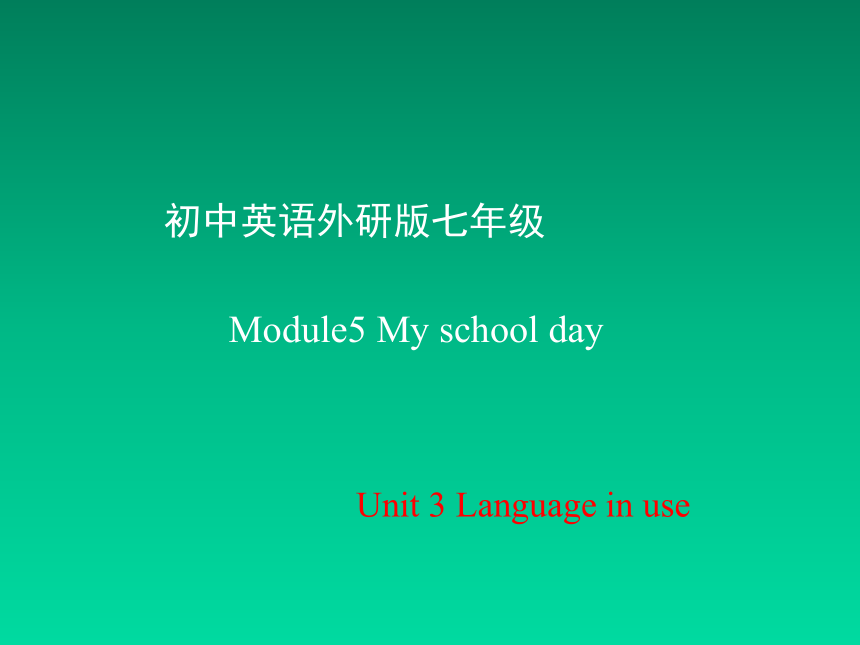 | |
| 格式 | ppt | ||
| 文件大小 | 4.1MB | ||
| 资源类型 | 教案 | ||
| 版本资源 | 外研版 | ||
| 科目 | 英语 | ||
| 更新时间 | 2022-06-22 19:22:35 | ||
图片预览

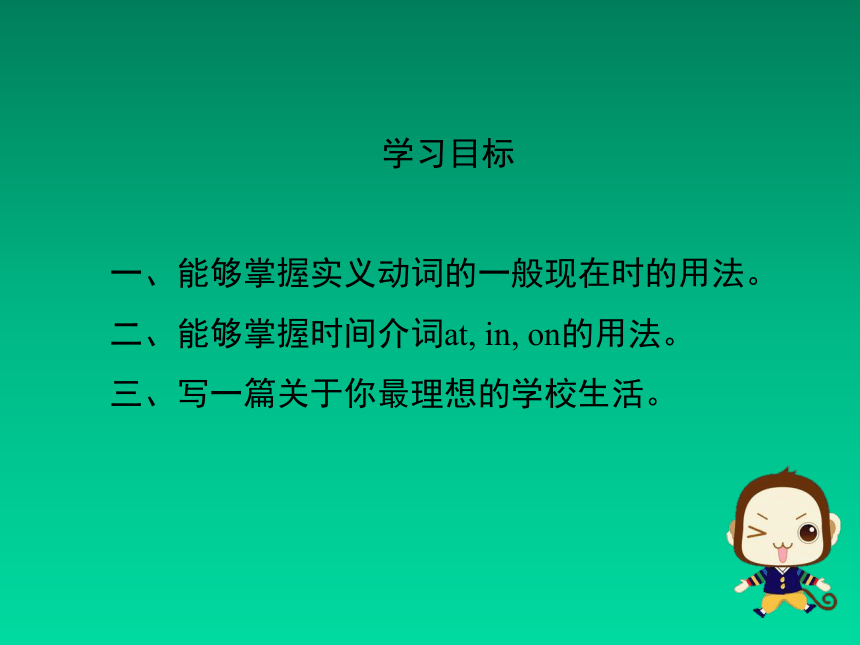
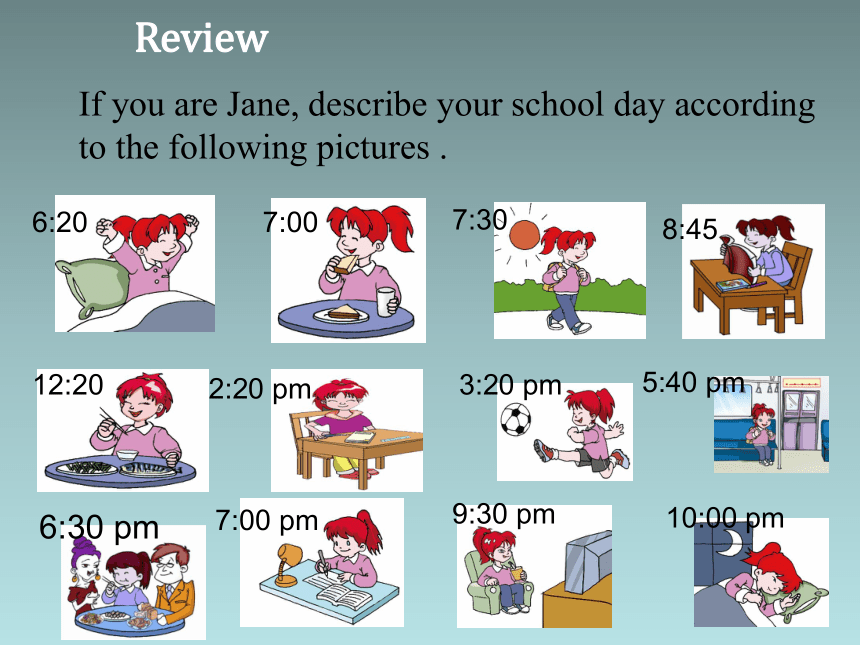
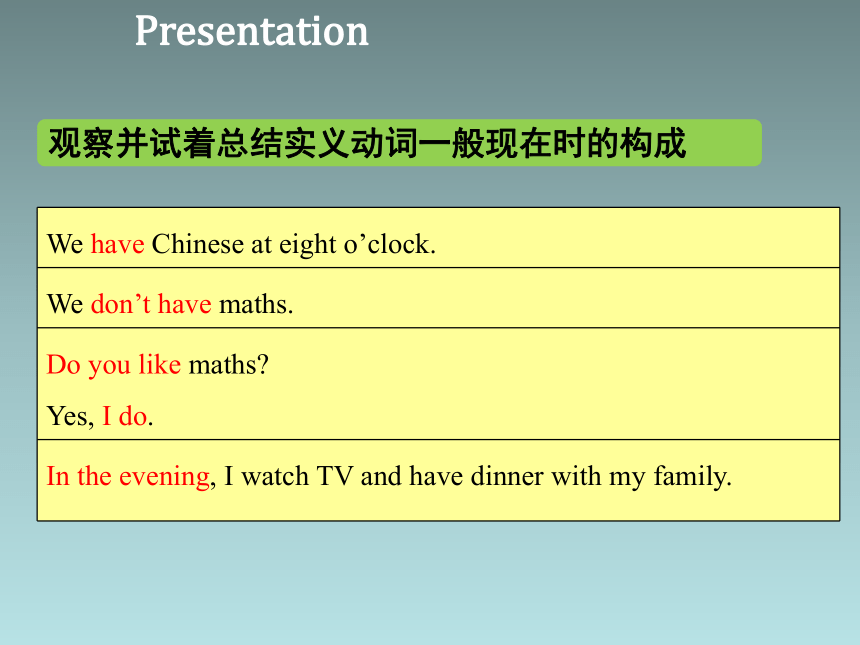

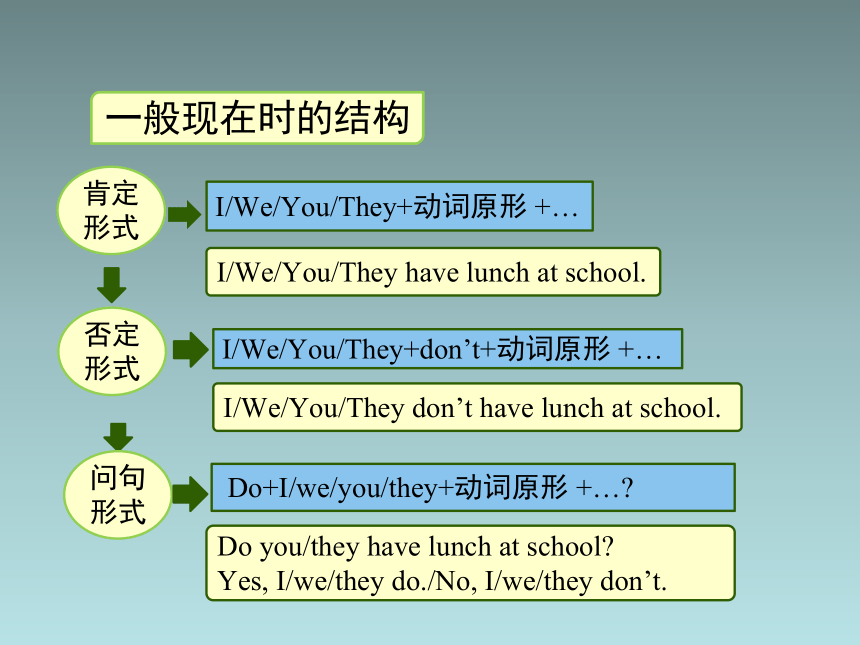
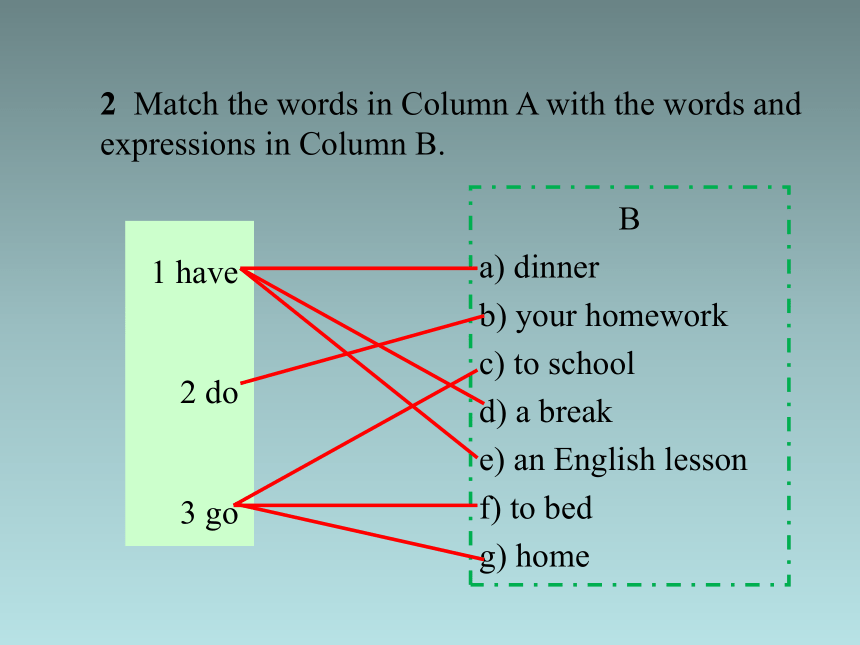
文档简介
(共18张PPT)
Unit 3 Language in use
Module5 My school day
初中英语外研版七年级
学习目标
一、能够掌握实义动词的一般现在时的用法。
二、能够掌握时间介词at, in, on的用法。
三、写一篇关于你最理想的学校生活。
Review
If you are Jane, describe your school day according to the following pictures .
6:20
7:00
7:30
8:45
12:20
2:20 pm
3:20 pm
5:40 pm
6:30 pm
7:00 pm
9:30 pm
10:00 pm
Presentation
We have Chinese at eight o’clock.
We don’t have maths.
Do you like maths
Yes, I do.
In the evening, I watch TV and have dinner with my family.
观察并试着总结实义动词一般现在时的构成
一般现在时
一般现在时的定义
用法1:表示现在经常性、习惯性发生的动作。
例:We go to school every day.
用法2:表示现在存在的特征、状态、能力、性格等。
例:I like English very much.
用法3:描述客观真理、客观存在或科学事实等。
例:The sun rises in the east.
一般现在时的结构
否定形式
问句形式
I/We/You/They+don’t+动词原形 +…
Do+I/we/you/they+动词原形 +…
I/We/You/They+动词原形 +…
I/We/You/They have lunch at school.
肯定形式
I/We/You/They don’t have lunch at school.
Do you/they have lunch at school
Yes, I/we/they do./No, I/we/they don’t.
2 Match the words in Column A with the words and expressions in Column B.
B
a) dinner
b) your homework
c) to school
d) a break
e) an English lesson
f) to bed
g) home
1 have
2 do
3 go
I go to school at half past seven in the morning. We have an English lesson at ten past eight. …
Talk about your school day
3 Complete the passage with the expressions from the box.
do homework get up go to school have a break have breakfast have lunch start work
On Friday I have a busy day. I (1)_________at half past six in the morning. Then I wash my hands and face, and (2)______________at seven. At half past seven, I (3)___________, and (4) ___________
at eight. There are four lessons in the morning.
go to school
get up
have breakfast
start work
At twenty to ten, we (5) ______________for twenty minutes. We go to the playground and I talk with my friends. We (6) __________ in the school dining hall. In the afternoon, we have two lessons and go home at half past three. I don’t (7) _____________ on Friday evening. I do it on Saturday.
do homework
have a break
have lunch
时间介词at, in, on
时间介词三兄弟
at
in
on
at
表示“某指定时间”,用于钟点时间前,也可用于一天中的某段特定时间,如黎明(dawn)、中午(noon)、 黄昏(dusk)、午夜 (midnight)等。
in
表示“在一段时间内或一天内的部分时间”,用于世纪、年、季节、月、一段时间或泛指一天中的上午、下午、晚上等前面。
on
表示“某一天或某一天内的部分时间”,用于星期名称、节日、具体的某一天或具体日子的上午、下午、晚上等前面。
口诀
世纪、年、月时间长,前面只有in能放;
星期、节日或某天,随手用on不会忘;
上午、下午和傍晚,泛指由in来相伴;
特指某天上、下午,还是应该使用on;
遇到几点或几分,使用at不用慌;
黎明、中午和黄昏,午夜时分at忙。
巧记口诀
4 Complete the sentences with at, in or on.
1. We go to school _____ the morning.
2. We don’t go to school _____ Sunday.
3. We don’t have a science lesson _____Wednesday.
4. I get up _____ seven o’clock.
5. We go home _____ the afternoon.
6. We have dinner _____ half past six.
in
in
on
on
at
at
5 Complete the sentences with the words from the box.
because break homework interesting subject
1 We have maths after_________ today.
2 I like maths. It’s my favourite ________.
3 Our maths teacher is very good and she makes it___________.
4 I like it_________ it’s interesting.
5 I do my maths _________ first after school every day.
homework
break
subject
because
interesting
The school day in the UK
In the UK, children have five lessons in the day and finish school at half past three in the afternoon. After school they go swimming, play football, have music lessons and play with their friends. They also do homework like you.
Module task: Talking about your ideal school day
1
2
3
Look through Module 5 and find expressions to say what you do and enjoy every day.
Complete the table with information about your ideal school day.
Talk about your ideal school day and write about it.
Homework
1. Write a passage about your ideal school day.
2. Surf the Internet for the information of the school day in other countries. You can make a timetable.
Unit 3 Language in use
Module5 My school day
初中英语外研版七年级
学习目标
一、能够掌握实义动词的一般现在时的用法。
二、能够掌握时间介词at, in, on的用法。
三、写一篇关于你最理想的学校生活。
Review
If you are Jane, describe your school day according to the following pictures .
6:20
7:00
7:30
8:45
12:20
2:20 pm
3:20 pm
5:40 pm
6:30 pm
7:00 pm
9:30 pm
10:00 pm
Presentation
We have Chinese at eight o’clock.
We don’t have maths.
Do you like maths
Yes, I do.
In the evening, I watch TV and have dinner with my family.
观察并试着总结实义动词一般现在时的构成
一般现在时
一般现在时的定义
用法1:表示现在经常性、习惯性发生的动作。
例:We go to school every day.
用法2:表示现在存在的特征、状态、能力、性格等。
例:I like English very much.
用法3:描述客观真理、客观存在或科学事实等。
例:The sun rises in the east.
一般现在时的结构
否定形式
问句形式
I/We/You/They+don’t+动词原形 +…
Do+I/we/you/they+动词原形 +…
I/We/You/They+动词原形 +…
I/We/You/They have lunch at school.
肯定形式
I/We/You/They don’t have lunch at school.
Do you/they have lunch at school
Yes, I/we/they do./No, I/we/they don’t.
2 Match the words in Column A with the words and expressions in Column B.
B
a) dinner
b) your homework
c) to school
d) a break
e) an English lesson
f) to bed
g) home
1 have
2 do
3 go
I go to school at half past seven in the morning. We have an English lesson at ten past eight. …
Talk about your school day
3 Complete the passage with the expressions from the box.
do homework get up go to school have a break have breakfast have lunch start work
On Friday I have a busy day. I (1)_________at half past six in the morning. Then I wash my hands and face, and (2)______________at seven. At half past seven, I (3)___________, and (4) ___________
at eight. There are four lessons in the morning.
go to school
get up
have breakfast
start work
At twenty to ten, we (5) ______________for twenty minutes. We go to the playground and I talk with my friends. We (6) __________ in the school dining hall. In the afternoon, we have two lessons and go home at half past three. I don’t (7) _____________ on Friday evening. I do it on Saturday.
do homework
have a break
have lunch
时间介词at, in, on
时间介词三兄弟
at
in
on
at
表示“某指定时间”,用于钟点时间前,也可用于一天中的某段特定时间,如黎明(dawn)、中午(noon)、 黄昏(dusk)、午夜 (midnight)等。
in
表示“在一段时间内或一天内的部分时间”,用于世纪、年、季节、月、一段时间或泛指一天中的上午、下午、晚上等前面。
on
表示“某一天或某一天内的部分时间”,用于星期名称、节日、具体的某一天或具体日子的上午、下午、晚上等前面。
口诀
世纪、年、月时间长,前面只有in能放;
星期、节日或某天,随手用on不会忘;
上午、下午和傍晚,泛指由in来相伴;
特指某天上、下午,还是应该使用on;
遇到几点或几分,使用at不用慌;
黎明、中午和黄昏,午夜时分at忙。
巧记口诀
4 Complete the sentences with at, in or on.
1. We go to school _____ the morning.
2. We don’t go to school _____ Sunday.
3. We don’t have a science lesson _____Wednesday.
4. I get up _____ seven o’clock.
5. We go home _____ the afternoon.
6. We have dinner _____ half past six.
in
in
on
on
at
at
5 Complete the sentences with the words from the box.
because break homework interesting subject
1 We have maths after_________ today.
2 I like maths. It’s my favourite ________.
3 Our maths teacher is very good and she makes it___________.
4 I like it_________ it’s interesting.
5 I do my maths _________ first after school every day.
homework
break
subject
because
interesting
The school day in the UK
In the UK, children have five lessons in the day and finish school at half past three in the afternoon. After school they go swimming, play football, have music lessons and play with their friends. They also do homework like you.
Module task: Talking about your ideal school day
1
2
3
Look through Module 5 and find expressions to say what you do and enjoy every day.
Complete the table with information about your ideal school day.
Talk about your ideal school day and write about it.
Homework
1. Write a passage about your ideal school day.
2. Surf the Internet for the information of the school day in other countries. You can make a timetable.
同课章节目录
- Starte
- Module 1 My teacher and my friends
- Module 2 My English lesson
- Module 3 My English book
- Module 4 My everyday life
- Module 1 My classmates
- Unit 1 Nice to meet you.
- Unit 2 I'm Wang Lingling and I'm thirteen years ol
- Unit 3 Language in use.
- Module 2 My family
- Unit 1 Is this your mum?
- Unit 2 These are my parents.
- Unit 3 Language in use.
- Module 3 My school
- Unit 1 There are thirty students in my class.
- Unit 2 The library is on the left of the playgroun
- Unit 3 Language in use.
- Module 4 Healthy food
- Unit 1 We've got lots of apples.
- Unit 2 Is your food and drink healthy?
- Unit 3 Language in use.
- Module 5 My school day
- Unit 1 I love history.
- Unit 2 We start work at nine o'clock.
- Unit 3 Language in use.
- Revision module A
- Module 6 A trip to the zoo
- Unit 1 Does it eat meat?
- Unit 2 The tiger lives in Asia.
- Unit 3 Language in use.
- Module 7 Computers
- Unit 1 How do I write my homework on the computer?
- Unit 2 When do you use a computer?
- Unit 3 Language in use.
- Module 8 Choosing presents
- Unit 1 I always like birthday parties.
- Unit 2 She often goes to concerts.
- Unit 3 Language in use.
- Module 9 People and places
- Unit 1 We're enjoying the school trip a lot.
- Unit 2 They're waiting for buses or trains.
- Unit 3 Language in use.
- Module 10 Spring Festival
- Unit 1 Are you getting ready for Spring Festival?
- Unit 2 My mother's cleaning our houses and sweepin
- Unit 3 Language in use.
- Revision module B
